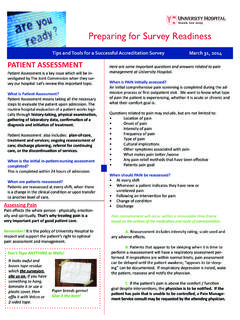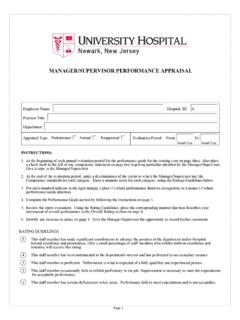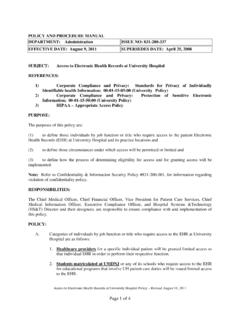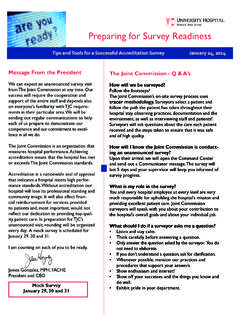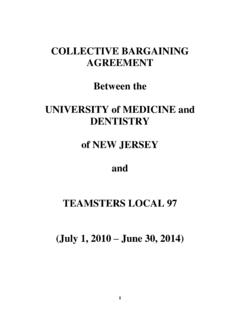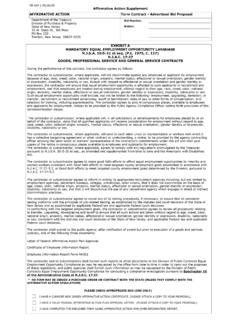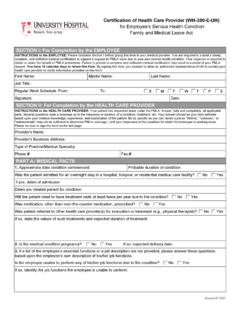Transcription of P&T Update - University Hospital
1 First Quarter 2015 Vol. XII, Issue 1P&T UpdateSpecial Points of Interest: P&T Update -Formulary Addition/Deletion Policy and Procedures Update Vancomycin and Zosyn: Isthere an increase in the risk ofacute renal toxicity when usedtogether? Hydroxyurea for the treatmentof Sickle Cell Disease Meet our three new clinicalpharmacy specialistsEDITORS:Andre Emont,Pharmacy DirectorVictor Pardo,Operations ManagerMichael Chu,Clinical Pharmacy Manager Nishat Faruqui,Clinical PharmacistHelen Horng,Clinical PharmacistPolly Jen,Clinical PharmacistMary Soliman,Clinical PharmacistGregory Eilinger,Clinical PharmacistMerlin Punnoose,Clinical PharmacistFormulary Addition/Deletion1. Elvitegravir/cobicistat/emtricitabine/te nofovir (Stribild ) addition request Stribild is a combination of 4 products with 2 NRTIs, one integrase inhibitor(INSTI) and a CYP3A inhibitor.
2 Formulary addition approved2. Dolutegravir (Tivicay ) addition requestDolutegravir is an integrase strand transfer inhibitor (INSTI). It blocks integraseactivity, an enzyme responsible for the integration of HIV DNA into the hostgenomic DNA, leading to propagation of infection through HIV provirus is considered as first line treatment option in combination withemtricitabine/tenofovir or abacavir/lamivudine for HIV-1 infected treatment na ve &experienced patients in age 12 years or older. Formulary addition approved3. Pancrease formulary reinstatement Pancrease (lipase, amylase, protease) was deleted from the Hospital formulary in July2010 following manufacturer discontinuation. The medication is now commerciallyavailable again, so a formulary reinstatement was proposed.
3 Formularyreinstatement approved4. Pralidoxime chloride (Protopam ) 1g vials Pralidoxime vials have been discontinued by the manufacturer. Formulary deletion approved5. Erythromycin sulfisoxazole (Pediazole ) Erythromycin sulfisoxazole oral liquid has been discontinued by the manufacturer. Formulary deletion approvedPolicies & Procedures/Floor Stock Update1. Computerized order entry and verification of medication orders, medicationadministration, standard medication time schedule P&P revision. Policy revision approved2. Patient Care Services reporting of ADR or Medication event P&P revision831-200-057 Patient Care Services Reporting Including Adverse Drug Reactions &Medication Errors Policy and Procedure revision to include reporting of device orproduct adverse event or error and reporting to FDA.
4 Policy revision approved3. Investigational Drug Service P&P revision707-600-117; 831-200-154 Investigational Drug Service Policy and Procedurerevision to Update the fee schedule. The new fee is more in line with recent University Healthcare Consortium (UHC) Hospital list serve benchmark. Policy revision approved4. Alaris smart pump drug libraryAlaris smart pump module expansion to include PCA pumps and syringe pumps were rolled-out on September 23rd 2014. Post roll-out, more smart pump druglibrary revisions were Propofol bolus infusion rate change for ICU and anesthesia from 5mg/min to500mg/min.(Continued on page 2)2 Policies & Procedures/Floor Stock Update (Continued from page 1)Morphine PCA standard concentration and HIGH dose concentration four hours max dose limit havebeen changed in all patient care PCA standard concentration and HIGH doseconcentration four hours max dose limit have beenchanged in all patient care PCA standard concentration andHIGH dose concentration four hours max dose limithave been changed in all patient care syringe built for OR use.
5 Libraryrevisions approved6. Guidelines for recombinant factor VIIa (NovoSeven)use at University Hospital Guidelines approved7. A P&P revision addressing ordering/scheduling ofantibiotic orders made to allow first dose of antibioticas STAT or NOW. For antibiotics not designed as STATor NOW by the ordering provider, pharmacists willexercise discretion in adjusting administration time toensure first dose is given within 2 Potassium chloride single dose and replacement maxfollow-up 707-600-157: ordering, administration andmonitoring of potassium replacements. policy revision9. The revised policy sets maximum replacement limitsof 120mEq per order (IV or oral) and 40mEq persingle oral dose. Serum potassium levels must beobtained before any further replacement can beordered and administered.
6 The Epic medicationrecords for potassium chloride will be modified toimplement the maximum dose limits and otherpolicy requirements. Policy revisions Automatic therapeutic exchange policy revision. The policy now allows pharmaciststo automatically interchange rapid acting insulinproducts (Novolog, Humalog) based on hospitalavailability. A physician may override such asubstitution if they specifically write do notexchange/substitute in the medication order entryfield. Policy revision approved11. 707-800-103 Multidose vial policy updateRevisions to the multidose vial policy includediscarding of the multidose vial (MDV) after a singletime use once brought to the patient bedside. thisupdate supersedes the older version of the policywhich indicated to discard all the multidose vialsafter single use in certain areas of the hospitalincluding ER, OR, PACU and areas without amedication room, or whenever a MDV was broughtoutside the medication room.
7 Policy revisionsapproved12. 707-400-108 Code Cart policy updateThe Code Cart policy has been updated to removevasopressin from the adult and pediatric code cartcontent list. Policy revisions approved13. 601-100-1162 Enteral Nutrition Policy UpdateThe Enteral Nutrition Policy has been revised by thePCS, nutrition and pharmacy department. Policy revisions approved3 Vancomycin is a glycopeptide antibiotic which isused for treatment of gram-positive infections,including methycillin-resistant Staphylococcus aureus(MRSA). Vancomycin is known to cause nephrotoxicityespecially when used concomitantly with otherantibiotics that are nephrotoxic (like aminoglycosides).The dose is adjusted based on the trough levels andkidney function, to avoid acute renal failure.
8 Thenephrotoxicity caused by vancomycin varies widely,however, in recent years there has been an increase inthe incidence of nephrotoxicity. The increase might bedue to an increase in MRSA infections or other severeinfections with higher MIC (minimum inhibitorconcentrations). The risk of vancomycin-associatednephrotoxicity increases when the trough level is 15 (piperacillin and tazobactam) is an extendedspectrum - lactamase inhibitor. It is used to treatinfections that are caused by - lactamase producingmicroorganisms and organisms that are susceptible toZosyn . It is commonly used for Pseudomonasaeruginosainfections. Zosyn also is known to causenephrotoxicity, however, the incidence ofnephrotoxicity is not very common (<1% based onpackage insert).
9 Dose adjustment is recommendedwhen creatinine clearance <40 and Zosyn are commonly usedempirically to treat severe infections. The data onvancomycin and Zosyn induced acute nephrotoxicityis still limited. A retrospective cohort study done byBurgess et al. evaluated the incidence of nephrotoxicityin patients who received vancomycin with or withoutZosyn and had normal baseline renal function. Theresults of that study showed that nephrotoxicity washigher in patients who received vancomycin andZosyn as a combination ( ) than in patientswho had received vancomycin as monotherapy( ) (p = )3. The study also showed that therisk of nephrotoxicity is higher when vancomycintrough levels are 15mg/L. Another retrospectivematched-cohort study done by Gomes et al.
10 Evaluatedthe incidence of acute kidney injury in adults whoreceived either vancomycin and Zosyn or vancomycinand cefepime. The patients had normal baseline renalfunction at the time of antibiotic administration. Theincidence of acute kidney injury in vancomycin-Zosyn group was higher ( ) than vancomycin-cefepimegroup ( ). Both of these cohort studies suggestthat when vancomycin and Zosyn are used togetherthe risk of acute kidney injury is higher compared tousing on the provided data it can be concluded thatthe concomitant use of vancomycin and Zosyn increases the risk of nephrotoxicity in patients; howeverthere are more studies which need to be conducted tovalidate the results. The mechanism of injury with thiscombination is unknown.
